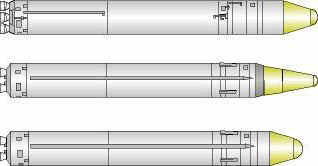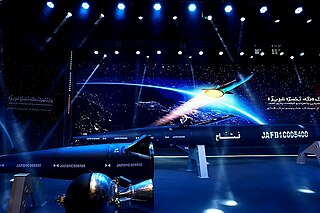
A cruise missile is an unmanned self-propelled guided vehicle that sustains flight through aerodynamic lift for most of its flight path and whose primary mission is to place an ordnance or special payload on a target. Cruise missiles are designed to deliver a large warhead over long distances with high precision. Modern cruise missiles are capable of traveling at high subsonic, supersonic, or hypersonic speeds, are self-navigating, and are able to fly on a non-ballistic, extremely low-altitude trajectory.

An intercontinental ballistic missile (ICBM) is a ballistic missile with a range greater than 5,500 kilometres (3,400 mi), primarily designed for nuclear weapons delivery. Conventional, chemical, and biological weapons can also be delivered with varying effectiveness, but have never been deployed on ICBMs. Most modern designs support multiple independently targetable reentry vehicle (MIRVs), allowing a single missile to carry several warheads, each of which can strike a different target. The United States, Russia, China, France, India, the United Kingdom, Israel, and North Korea are the only countries known to have operational ICBMs.

The maneuverable reentry vehicle is a type of warhead for ballistic missiles that is capable of maneuvering and changing its trajectory.

The UR-100N, also known as RS-18A, is an intercontinental ballistic missile in service with Soviet and Russian Strategic Missile Troops. The missile was given the NATO reporting name SS-19 Stiletto and carries the industry designation 15A30.

Hypersonic flight is flight through the atmosphere below altitudes of about 90 km at speeds greater than Mach 5, a speed where dissociation of air begins to become significant and high heat loads exist. Speeds over Mach 25 have been achieved below the thermosphere as of 2020.
Conventional Prompt Strike (CPS), formerly called Prompt Global Strike (PGS), is a United States military effort to develop a system that can deliver a precision-guided conventional weapon strike anywhere in the world within one hour, in a similar manner to a nuclear ICBM. Such a weapon would allow the United States to respond far more swiftly to rapidly emerging threats than is possible with conventional forces. A CPS system could also be useful during a nuclear conflict, potentially replacing the use of nuclear weapons against up to 30% of targets. The CPS program encompasses numerous established and emerging technologies, including conventional surface-launched missiles and air- and submarine-launched hypersonic missiles, although no specific CPS system has yet been finalized as of 2018.
An anti-ship ballistic missile (ASBM) is a military ballistic missile system designed to hit a warship at sea.

The Alpha Draco missile, also known as Weapons System 199D (WS-199D), was an experimental ballistic missile developed by McDonnell Aircraft in the late 1950s to investigate the aerodynamic physics of the boost-glide reentry trajectory. Three test flights were conducted in 1959, of which two were successful.
The DF-ZF is a hypersonic glide vehicle (HGV) developed by the People's Republic of China. It is launched by the DF-17 medium-range ballistic missile. The combined weapon system was likely operational by October 2019.

Non-ballistic atmospheric entry is a class of atmospheric entry trajectories that follow a non-ballistic trajectory by employing aerodynamic lift in the high upper atmosphere. It includes trajectories such as skip and glide.

The Hwasong-12 is a mobile intermediate-range ballistic missile developed by North Korea. The Hwasong-12 was first revealed to the international community in a military parade on 14 April 2017 celebrating the Day of the Sun which is the birth anniversary of North Korea's founding President, Kim Il Sung. North Korea tested Hwasong-12 on 30 January 2022.

The Avangard is a Russian hypersonic glide vehicle (HGV) that can be carried as an MIRV payload by the UR-100UTTKh, R-36M2 and RS-28 Sarmat heavy ICBMs. It can deliver both nuclear and conventional payloads. The Avangard is reportedly capable of travelling at re-entry speeds.

The Dongfeng-17, is a Chinese solid-fuelled road-mobile medium-range ballistic missile designed to carry the DF-ZF hypersonic glide vehicle.

A hypersonic weapon is a weapon capable of travelling at hypersonic speed, defined as between 5 and 25 times the speed of sound or about 1 to 5 miles per second.

The AGM-183 ARRW is a hypersonic air-to-ground ballistic missile planned for use by the United States Air Force. Developed by Lockheed Martin, the boost-glide vehicle is propelled to a maximum speed of more than Mach 5 by a rocket motor before gliding toward its target. The program was cancelled in March 2023 after multiple failed tests. The program, however, continued despite the cancellation and was announced to still be in development following additional, undisclosed testing.

The HGV-202F is an Indian hypersonic glide vehicle (HGV) being designed, developed, and manufactured by an Indian Defence and Space company HTNP Industries.
The Hwasong-8 is a North Korean missile claimed to be mounting a hypersonic glide vehicle, which was first tested on 14 September 2021. The first launch occurred in September, a month with a total of four missile launches. As it is supposedly a hypersonic missile, the higher speed would allow it to reach its target in shorter time and additional maneuverability would give it a better chance at defeating missile defenses. Japanese tracking data from a test launch suggest it is a hypersonic ballistic missile, as North Korea described it.

The Hwasong-18 is a North Korean three-stage solid-fuelled intercontinental ballistic missile (ICBM). It is the first solid-fuelled ICBM developed by North Korea, and was first unveiled at the 8 February 2023 parade commemorating the 75th anniversary of the founding of the Korean People's Army. Its maiden flight occurred on 13 April 2023.

Fattah-1 is an Iranian hypersonic medium-range ballistic missile developed by the Islamic Revolutionary Guard Corps and unveiled in 2023. It is Iran's first hypersonic ballistic missile. According to Iran, its high maneuverability and speed allows it to defeat all missile defence systems.
The Hwasong-16b is a North Korean hypersonic Intermediate-range ballistic missile. First conceptually developed in 2015 as mock-ups in celebratory parades, on 20 October 2020, they were displayed as part of the 75th anniversary of the Workers' Party of Korea parade under the name of the Hwasong-16, which then subsequently was spun off as the Hwasong-17.















